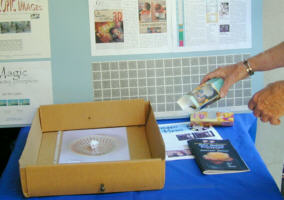 |
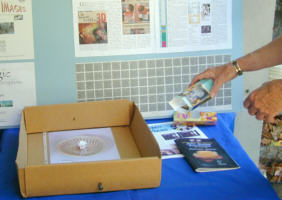 |
National
Stereoscopic Association Convention, July 7-12, 2004
and
Da Vinci Days, July 17-18 2004
 |
 |
view
the above (Da Vinci Days) with eyes crossed
see
also bottom of page
| In the box is a
phantogram by Terry Wilson
To the right of the box is the program for the NSA convention. The cover picture is a lenticular stereogram: a plastic cover over the printing sends different pictures to the right and left eye. The 3-D rose looks real; it stands out from the paper and we sense the we can run our fingers through the petals. Under the top edge of the program booklet is an issue of Stereo Views, the publication of the Cascade Stereoscopic Club, Inc. In the visitor's hand is a "The Amazing Card" stereoscopic viewer. See them at the Portland 3-D Center. |
The
photo in the lower left corner of the poster on the wall is a full color
anaglyph, demonstrating that even though anaglyph glasses block about half
the spectrum to each eye, the stereoscopic image, which combines the two
images, also recombines the colors sufficiently well to give us farily
full color perception,
The tile pattern to the rear is an array of random dot stereograms by Bela Julesz, the man who pioneered research on stereopsis. This tile pattern creates stereoscopic images through the wallpaper effect. On the far left is a poster, "See Like a Giant." SEE |
|
|
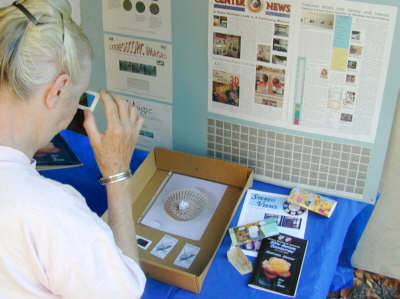
Phantograms arouse wonder and amazement. Look through the red and cyan glasses and you see a basket in that box. If the basket were sitting next to the phantogram, the actual basket and phantogram basket would look equally real! At the NSA convention many such real-object and phantogram pairs were there for all to look at . . . and utter,
The basket phantogram was made by Terry Wilson of Medford Lakes, New Jersey. You can see many of her phantograms here--as best they can be seen on the Web; however, you will need a pair of red-cyan glasses. And Terry's business card has startled and amazed everyone who has seen it. A small delicate origami bird occupies the space above the card, real and grabable. At least, most everyone tries to grab it. 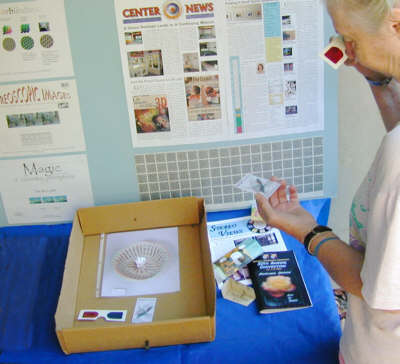
The scrap of trash is real, as you can see in the picture at the top of the page. |
See
some of those convention phantograms HERE(a
convention website; go to Friday).
The
phantogram/real object pairs were furnished by Steve Hughes of the Atlanta
(GA) Stereographic Assn: www.georgia3d.com
(Watch for his "An Introduction to Making Phantograms" on this website.)
|
|
1928 NW Lovejoy
Fri, Sat, Sun 1 - 5
pm
The center is the only Gallery & Museum in the U.S. dedicated solely to antique and contemporary 3D images, equipment, paraphernalia, and books. Monlhly featured artists
3D in Knowledge for Use The Knowledge for Use Project
was started in 1970 by the current webmasters
of Explore Portland Community (explorepdx.com,
this site) to disseminate unusual teaching materials that grew out of our
teaching experiences. Much of our work involves stereoscopic phenomena.
The Knowledge for Use logo, which first appeared on our stationery in 1972
was probably only the second ever single-image, multiple-stripe random-dot
stereogram. The development of stereopsis--and its failure, stereopsis
blindness--provide a useful exemplar for the family of critical-age mental
developments that seem to play a critical role in comprehension of the
more abstract aspects of knowledge, the aspects of science that make it
more useful to some than to others. Stereoscopic images have been
useful in topographic mapping (Multiplex, Kelsh Plotter, KEK Plotter, etc),
and learning and using these techniques has steered us in some very interesting
directions for using stereopsis. Look HERE
for an index to stereoscopic aspects of our web sites.
|
Phantograms are viewed differently from ordinary stereoscopic
photos, but the principles of the stereoscopic image (and the stereoscopic
model) are the same. Ordinarily, stereoscopic photos are made to
be viewed with the plane of the printing perpendicular to our line of sight.
Phantograms are made to be viewed at about 30 to 45 degrees from the plane
of the printing.
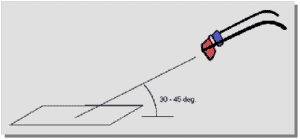 The stereoscopic image you see in a stereogram is what you would see were you looking at the original three-dimensional object. The photographs are set up to place the same images on your retinas. On an anaglyph, the images for both eyes are printed on a single sheet of paper and the anaglyph glasses (red-cyan) pass only the appropriate image to each eye. We see the scene in full stereoscopic depth. The edges of the two photos and/or the edges of the paper they are printed on add another stereoscopic feature: it's a kind of window through which we are viewing or a piece of paper associated with the stereoscopic images we see. In the stereo pair at the top of this page, the "window" has been adjusted to place the images, the "stereoscopic model," all on the other side of the window. In the phantograms described here, the stereoscopic images are placed to appear as though resting on the surface of the paper on which they are printed. The images we see are mostly coming from printed images on paper beyond the points in space at which the object appears to be located (while in the stereo image at the top of the page they come from the computer screen which is in front of the 3-D image we observe) and that gives the startling appearance of being in the space above the paper, which we also are seeing in 3-D. (Note that a phantogram stereoscopic image could just as well be placed beyond the printed paper. It wouldn't then have the startling visual quality of sitting on the paper.) Phantograms are also subject to the same relationships and rules of ordinary stereoscopic images which govern the scale of the model and distortions of the viewed model. A phantogram is designed to be viewed from one point in space; from an angle from the plane of the paper and from a distance from the paper. They are subject to distortion of the image (model) somewhat more than are ordinary stereograms. Furthermore, phantograms, lke ordinary stereograms, can be made to appear as though we, the observers, are gnats or giants by making the distance between the camera positions when taking the photos gnat-eye distance or giant-eye distance. . |
 |
 |
view the above with eyes spread